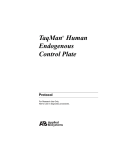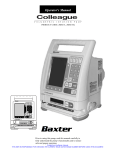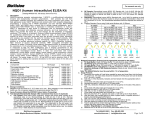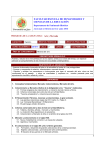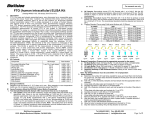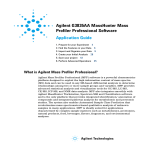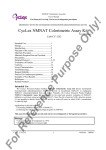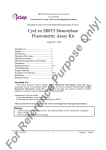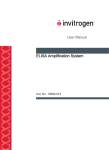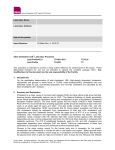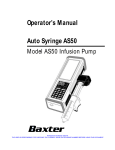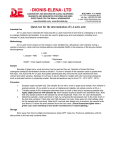Download CY-1253 NAD+/NADH Colorimetric Assay Kit
Transcript
Quantitative test kit for NAD+/NADH On ly! NAD+/NADH Colorimetric Assay Kit User’s Manual For Research Use Only, Not for use in diagnostic procedures CycLex NAD+/NADH Colorimetric Assay Kit For 100 Assays ce Pu Intended Use................................................1 Storage.........................................................1 Introduction..................................................2 Principle of the Assay..................................2 Materials Provided.......................................3 Materials Required but not Provided...........3 Precautions...................................................4 Detailed Protocol..........................................5-9 Evaluation of Results...................................10 Cautions........................................................11 Assay Characteristics...................................11 Troubleshooting...........................................11 Reagent Stability..........................................11 Example of Test Results...............................12-15 References....................................................16 Related Products...........................................17 rp os e Cat# CY-1253 Intended Use en The CycLex Research Product CycLex NAD+/NADH Colorimetric Assay Kit provides a convenient method for sensitive measurement of NAD+, NADH and their ratio. This kit is designed for specific detection of NAD+ and NADH by an enzyme cycling reaction. NAD+ and NADH extraction and neutralization buffers are NOT provided in this kit. er Applications for this kit include: 1) Measuring NAD+ and NADH concentrations in cell or tissue extracts. 2) Measuring NAD+/NADH ratio. 3) Detecting effects of pharmacological agents on cellular level of NAD+ and NADH. ef This assay kit is for research use only and not for use in diagnostic or therapeutic procedures. Storage rR • Upon receipt store all components at -70°C. • Don’t expose reagents to excessive light. Fo Cat#: CY-1253 1 Version#: 130823 On ly! NAD+/NADH Colorimetric Assay Kit User’s Manual For Research Use Only, Not for use in diagnostic procedures Introduction rp os e Nicotinamide adenine dinucleotide (NAD+) as well as nicotinamide adenine dinucleotide phosphate (NADP+) is an important cofactor found in cells. NADH is the reduced form of NAD+, and NAD+ is the oxidized form of NADH. It has been reported that NAD+ metabolism regulates important biological effects including life span. NAD+, through poly-ADP-ribosyl polymerase (PARP), mono-ADPribosyltransferase (ARTs) and recently characterized sirtuin enzymes, exerts potential biological effects. These enzymes modify proteins to regulate their function via ADP-ribosylation or deacetylation in the presence of NAD+. These enzymes are involved in several pathways including apoptosis, DNA repair, senescence and endocrine signaling, suggesting that either the enzymes could be an important therapeutical target for cancer, diabetes atherosclerosis and so on. The traditional NAD+/NADH and NADP+/NADPH assays are done by monitoring of NADH or NADPH absorption at 340 nm. This method suffers low sensitivity and high interference since the assay is done in the UV range that requires expensive quartz microplate. CycLex NAD+/NADH Colorimetric Assay Kit employs an enzyme cycling reaction, which significantly increases detection sensitivity, and provides a convenient method for sensitive detection of NAD+, NADH and their ratio. Principle of the Assay Pu Since it is very simple to measure and it can be performed at a low price, the measurement of NAD+ and NADH concentrations in most laboratories is possible if they are equipped with a microtiter plate reader. Considering that the use of fully automatic apparatus to monitor the absorbance has become widespread, NAD+ and NADH concentration measurement is now possible with the CycLex NAD+/NADH Colorimetric Assay Kit using the same equipment. This method of measurement should dramatically raise the efficiency of measuring NAD+ and NADH concentrations in mammalian cells and tissues. ADH Diapharase NAD+ WST-1-formazan er en EtOH ce Measuring Principle of The CycLex NAD+/NADH Colorimetric Assay Kit NADH WST-1 rR ef Acetoaldehyde Read A450 Fo Cat#: CY-1253 2 Version#: 130823 Materials Provided Each kit contains Materials Quantity 1.5 mL x 1 200 µL x 1 ③10X Standard Dilution Buffer ④50X WST-1 ⑤50X ADH (alcohol dehydrogenase) ⑥50X Diaphorase ⑦10X EtOH Solution ⑧Instruction manual 2 mL x 1 200 µL x 1 200 µL x 1 200 µL x 1 1 mL x 1 1 Materials Required but not Provided Storage -70°C -70°C -70°C -70°C -70°C -70°C rp os e ①10X NAD+/NADH Assay Buffer ②400 µM NADH On ly! NAD+/NADH Colorimetric Assay Kit User’s Manual For Research Use Only, Not for use in diagnostic procedures -70°C Room temp. • NAD+ Extraction Buffer (See page 5, section “Detailed Protocol”.) Pu • NADH extraction Buffer (See page 5, section “Detailed Protocol”.) • Neutralization Buffer for NAD+ extraction (See page 5, section “Detailed Protocol”.) • Neutralization Buffer for NADH extraction (See page 5, section “Detailed Protocol”.) • Water bath or heating block ce • Microplate for ELISA en • Plate reader capable of measuring absorbance in 96-well plates at dual wavelengths of 450 nm/540 nm. Dual wavelengths of 450/550 or 450/595 nm can also be used. The plate can also be read at a single wavelength of 450 nm, which will give a somewhat higher reading. • Pipettors: 2-20 µL, 20-200 µL and 200-1000 µL precision pipettors with disposable tips. • Multi-channel pipette er • Microplate shaker * Deionized water of the highest quality ef • Reagent reservoirs rR • FK866 (APO866): FK866 is available from Axon Medchem Cat# Axon 1279 or Cayman Cat.# 13287. Make 2.5 mM stock solution in DMSO (optional) • 1 N H2SO4: Stop solution (optional) Fo Cat#: CY-1253 3 Version#: 130823 On ly! NAD+/NADH Colorimetric Assay Kit User’s Manual For Research Use Only, Not for use in diagnostic procedures Precautions • Please thaw all reagents in crushed ice before use. • Please keep ADH (alcohol dehydrogenase) and diaphorase in this kit on ice and return them immediately to -70°C after use. There is a possibility that the enzyme activity may be inactivated. • Please avoid mixing of any reagents containing SH group like DTT or reduced glutathione, or alkyl amine in the sample that will interfere this assay. rp os e • Do not use kit components beyond the indicated kit expiration date. • Rinse all detergent residue from glassware. • Use deionized water of the highest quality. • Do not mix reagents from different kits. • Do not mouth pipette or ingest any of the reagents. Pu • Do not smoke, eat, or drink when performing the assay or in areas where samples or reagents are handled. • Biological samples may be contaminated with infectious agents. Do not ingest, expose to open wounds or breathe aerosols. Wear protective gloves and dispose of biological samples properly. rR ef er en ce • CAUTION: NAD+ Extraction Buffer and NADH extraction Buffer (Not provided in this kit) are a strong acid and alkaline, respectively. Wear disposable gloves and eye protection when handling Stop Solution (1 N H2SO4). Fo Cat#: CY-1253 4 Version#: 130823 Detailed Protocol On ly! NAD+/NADH Colorimetric Assay Kit User’s Manual For Research Use Only, Not for use in diagnostic procedures CycLex NAD+/NADH Colorimetric Assay Kit can measure NAD+ and NADH concentrations by enzyme cycling reaction using alcohol dehydrogenase (ADH), diaphorase and WST-1. Since the reaction is not stopped, it is necessary to monitor absorbance of WST-1-formazan at 450 nm at regular intervals after the reaction is initiated, and to determine appropriate reaction time. 1. Preparation of Assay Reagents rp os e 1. Prepare Extraction Buffers and Neutralization Buffers: Not provided in this kit * NAD+ Extraction Buffer: 0.5 M perchloric acid (HClO4) * NADH Extraction Buffer: 50 mM NaOH and 1mM EDTA * Neutralization Buffer for NAD+ extraction: 0.55 M K2CO3 * Neutralization Buffer for NADH extraction: 0.3 M potassium phosphate buffer (pH 7.4) 2. Thaw ①10X NAD+/NADH Assay Buffer at room temperature in water bath. Stand all other reagents on ice to thaw. Use them after they thaw completely. Pu 3. Prepare a working solution of Standard Dilution Buffer by diluting ③10X Standard Dilution Buffer 1:10 with distilled water. Mix well. Store at 4°C for two weeks or -20°C for long term storage. 4. Prepare NADH Standards as follows: Use ②400 µM NADH to produce a serial dilution series (below). Mix each tube thoroughly before the next transfer. The 4,000 nM standard (Std.1) serves as the high standard. The NADH Standard Dilution Buffer serves as the zero standard (Blank). en 10 µL of ②400 µM NADH 100 µL of Std. 1 (4,000 nM) 100 µL of Std. 2 (2,000 nM) 100 µL of Std. 3 (1,000 nM) 100 µL of Std. 4 (500 nM) 100 µL of Std. 5 (250 nM) 100 µL of Std. 6 (125 nM) er Std.1 Std.2 Std.3 Std.4 Std.5 Std.6 Std.7 Blank ce Volume of Standard - Standard Dilution Buffer 990 µL 100 µL 100 µL 100 µL 100 µL 100 µL 100 µL 100 µL Concentration 4,000 nM 2,000 nM 1,000 nM 500 nM 250 nM 125 nM 62.5 nM 0 ng/mL ef Note-1: Do not use a Repeating pipette. Change tips for every dilution. Wet tip with Standard before dispensing. Unused portions of NADH Standards should be discarded. rR Note-2: Since NAD+ is converted to NADH in enzyme cycling reaction and relatively labile than NADH, CycLex only provides NADH Standard. Fo Cat#: CY-1253 5 Version#: 130823 On ly! NAD+/NADH Colorimetric Assay Kit User’s Manual For Research Use Only, Not for use in diagnostic procedures 5. Prepare NAD+/NADH Reaction Buffer (Quantity Required: 75 µL/assay) ・Mix following reagents and put in ice. ・Please use within 30 min after prepared this NAD+/NADH Reaction Buffer. Discard any unused NAD+/NADH Reaction Buffer after use. Assay reagents Volume ①10X NAD+/NADH Assay Buffer ④50X WST-1 10 µL rp os e 2 µL ⑤50X ADH 2 µL ⑥50X Diaphorase 2 µL ⑦10X EtOH Solution 10 µL dH2O 49 µL 75 µL rR ef er en ce Pu Total Fo Cat#: CY-1253 6 Version#: 130823 On ly! NAD+/NADH Colorimetric Assay Kit User’s Manual For Research Use Only, Not for use in diagnostic procedures 2. Preparation of Sample Numerous extraction methods can be used to isolate NAD+ and NADH. The following protocols for NAD+ and NADH have been shown to work with a number of different mammalian cell lines are provided as examples of suitable methods. If desired, you can employ other methods for extraction of NAD+ and NADH. All extraction and neutralization buffers are not provided in this kit. rp os e Determination of NAD+ and NADH requires two separate samples (acid extract for NAD+ and alkaline extract for NADH), utilizing the character of NAD+; resistant to acidic condition and heat labile and NADH: resistant to alkaline condition and relatively heat stable. Preparation of Cell Extract 1. For adherent cells, after washing with PBS, trypsinize, harvest and transfer the cells (1-5 x 106 cells) to microcentrifuge tubes followed by centrifugation at 2,000 rpm for 5 min. Note: Each investigator should optimize the number of cells used per test. or Pu For non-adherent cells, harvest and transfer the cells (1-5 x 106 cells) to microcentrifuge tubes followed by centrifugation at 2,000 rpm for 5 min. Note: Each investigator should optimize the number of cells used per test. 2. Wash the cells twice with cold PBS by centrifugation at 2,000 rpm for 5 min. 3. Spin down the cells by microcentrifuge at 10,000 rpm for 1 min. Aspirate the supernatant; remove as much of the PBS as possible. ce For NAD+ measurement 4. Vortex the cell pellet gently. Extract the cells with 100 µL of NAD+ Extraction Buffer (See page 5) by vortexing 3-4 times for 1 min each with same time intervals or by homogenization using standard techniques (i.e. sonicate 4 times for 5 sec each on ice.). Then stand for 30 min on ice. en 5. Add 100 µL of Neutralization Buffer for NAD+ extraction (See page 5) to the acid extract and mix well by vortexing for neutralization. er 6. Spin the neutralized cell extract above at 15,000 rpm for 5 min at 4°C. Transfer a supernatant to new microcentrifuge tube. (The final pH of the supernatant should be 7.5–8.5. Please make sure that the pH is within this range. If not, adjust pH 7.5–8.5 using either Neutralization Buffers for NAD+ extraction or for NADH extraction, see page 5.). ef 7. Keep the tube of the cell extract for NAD+ measurement (refer to as an acid extract: “AcE”) on ice, which is ready to go to “step 8” for NAD+ measurement. rR 8. Measure protein concentration, for example using the BCA protein assay, data can be normalized and expressed as pmol NAD+ /mg of protein. Fo Cat#: CY-1253 7 Version#: 130823 On ly! NAD+/NADH Colorimetric Assay Kit User’s Manual For Research Use Only, Not for use in diagnostic procedures For NADH measurement 4’. Vortex the cell pellet gently. Extract the cells with 100 µL of NADH Extraction Buffer (See page 5) by vortexing 2-3 times for 1 min each with same time intervals or by homogenization using standard techniques (i.e. sonicate 4 times for 5 sec each on ice.). Then incubate at 60 °C for 30 min to reduce the viscosity of the samples. rp os e 5’. Add 100 µL of Neutralization Buffer for NADH extraction (See page 5) to the alkaline extract and mix well by vortexing for neutralization, then stand on ice for at least 5 min. 6’. Spin the neutralized cell extract at 15,000 rpm for 5 min at 4°C. Transfer a supernatant to new microcentrifuge tube (The final pH of the supernatant should be 7.5–8.5. Please make sure that the pH is within this range. If not, adjust pH 7.5–8.5 using either Neutralization Buffers for NAD+ extraction or for NADH extraction, see page 5.). 7’. Keep the tube of the cell extract for NADH measurement (refer to as an alkaline extract: “AlE”) on ice, which is ready to go to “step 8” for NADH measurement. 8’. Measure protein concentration, for example using the BCA protein assay, data can be normalized and expressed as pmol NADH /mg of protein. Pu Note-1: If necessary, the cell extract can be stored at -70°C. Avoid multiple freeze/thaw cycles. After thaw the cell extract, centrifuge at 15,000 rpm for 15 minutes at 4°C again since the cell extract should be clear of any sediments or particulate matters. However this may result in some loss of NAD/NADH. ce Note-2: Although this protocol has been successfully applied to many mammalian cell lines, users should optimize the cell extraction procedure for their own applications. en Note-3: Although we suggest to conduct experiments as outlined above, the optimal experimental conditions will vary depending on the parameters being investigated, and must be determined by the individual user. Especially, please make sure the final preparations of cell extract are in neutral pH, hopefully, pH 7.5-8.5. rR ef er CycLex does NOT recommend to use sodium carbonate-based buffer as a NAD+/NADH extraction buffer instead of acid extraction buffer and alkaline extraction buffer for NAD+ and NADH extraction, respectively, because the extracts prepared by using sodium carbonate-based buffer give you an inappropriate NAD+ and NADH concentrations and ratio (See Fig. 6 and 7 at page 14 and 15). Fo Cat#: CY-1253 8 Version#: 130823 3. NAD+/NADH Assay Procedures On ly! NAD+/NADH Colorimetric Assay Kit User’s Manual For Research Use Only, Not for use in diagnostic procedures Assay reagents Test sample NADH Standard NAD+/NADH Reaction Buffer (see page 6) 75 µL 75 µL - 25 µL 25 µL - NADH Standards rp os e Your sample (Test sample) 1. Following the above table, add 25 µL of NADH Standards (Std.1-Std.7 and Blank: Standard Dilution Buffer) and Your sample to each well of microplate. Next, initiate reaction by adding 75 µL of NAD+/NADH Reaction Buffer to the each well and mix thoroughly. Incubate at room temperature (ca.25°C). 2. Monitor the absorbance at 450 nm for 30 to 90 minutes at 10 min intervals using microplate reader. 2’. Alternatively, after 60 min or appropriate time incubation, the reactions can be stopped by adding 50 µL of Stop Solution 1 N H2SO4 (not provided in this kit) into each well and mix well. Take a reading with the absorbance at 450 nm. Pu Table. Layout of NADH standards and test samples (AcE and AlE) in 96-well microplate: 2 3 4 A Blank Blank AcE-1 AcE-1 B Std.7 Std.7 AlE-1 AlE-1 C Std.6 Std.6 AcE-2 AcE-2 D Std.5 Std.5 AlE-2 AlE-2 E Std.4 Std.4 AcE-3 AcE-3 F Std.3 Std.3 AlE-3 AlE-3 G Std.2 Std.2 AcE-4 AcE-4 H Std.1 Std.1 AlE-4 AlE-4 5 6 7 8 9 10 11 12 er en ce 1 AcE: Acid Extract AlE: Alkaline Extract rR ef Note: The NADH standards and test samples should be run in duplicate. Fo Cat#: CY-1253 9 Version#: 130823 Evaluation of Results 1. Run reactions as described in the Detailed Protocol. 2. Subtract A450 at the 0 time from all reaction time points. 3. Plot A450 versus reaction time. 4. Determine the reaction time range in which the increase in A450 is linear. 5. Fix an appropriate reaction time (usually 60 min). 6. Take a reading with the absorbance at 450 nm. On ly! NAD+/NADH Colorimetric Assay Kit User’s Manual For Research Use Only, Not for use in diagnostic procedures rp os e Average the duplicate readings for each standard, control, and sample and subtract the average zero standard (Std.7) optical density. Plot the optical density for the standards versus the concentration of the standards and draw the best curve. The data can be linearized by using log/log paper and regression analysis may be applied to the log transformation. To determine the NAD+ or NADH concentration of each sample, first find the absorbance value on the y-axis and extend a horizontal line to the standard curve. At the point of intersection, extend a vertical line to the x-axis and read the corresponding NAD+ or NADH concentration. If the samples have been diluted, the concentration read from the standard curve must be multiplied by the dilution factor (See Fig. 2. NADH Standard curve at page 12). 1. The results of unknown samples can be calculated with any computer program having a 5-parameter logistic function. It is important to make an appropriate mathematical adjustment to accommodate for the dilution factor. Pu 2. Most microplate readers perform automatic calculations of analyte concentration. The calibration curve is constructed by plotting the absorbance (Y) of calibrators versus log of the known concentration (X) of calibrators, using the four-parameter function. ce 3. The concentration of NAD+ or NADH in the sample can be calculated, then divide the NAD+ or NADH concentration by the sample amount (e.g. cell number or extract protein amount) you added into the sample wells. The concentration of NAD+ or NADH can be expressed in pmol/106 cells or pmol/mg protein. NAD+ concentration of AcE (nM) x 2 x 105 /cell number NADH concentration (pmol/106 cells) = NADH concentration of AlE (nM) x 2 x 105 /cell number en NAD+ concentration (pmol/106 cells) = er Total volume of AcE = 200 µL. Volume of AcE for assay = 25 µL. Total volume of AlE = 200 µL. Volume of AlE for assay = 25 µL. NAD+/NADH Ratio = NAD+ concentration (pmol/106 cells) NADH concentration (pmol/106 cells) ef Note-1: The absorbance background increases with time, thus it is important to subtract the absorbance value of the zero standard (Std.7) wells for each data point. rR Note-2: Usually, an appropriate reaction time is from 60 to 90 min. This value is variable depending on reaction conditions and preparation of cell extract. Decreasing the amount of cell extract in the assay may help to lengthen the time range. Fo Cat#: CY-1253 10 Version#: 130823 Cautions On ly! NAD+/NADH Colorimetric Assay Kit User’s Manual For Research Use Only, Not for use in diagnostic procedures 1. Since this kit is based on enzyme cycling reaction, it is not possible to measure NAD+ and NADH concentration in conventional crude cell extract without special extraction and treatment for NAD+ and NADH. Please follow the section “Preparation of Sample” at page 7-8. 2. Please avoid mixing of any reagents containing SH group like DTT or reduced glutathione, or alkyl amine in the sample that will interfere this assay. rp os e For research use only, not for use in diagnostic or therapeutic procedures. Assay Characteristics The CycLex Research Product CycLex NAD+/NADH Assay kit has been shown to measure NAD+ and NADH concentrations or NAD+/NADH ratio crude cell extract using enzyme cycling reaction. The assay shows good linearity of sample response. Troubleshooting 1. When test sample have not adjusted to neutral pH, Enzyme cycling reaction might be inhibited, so that NAD+ and NADH concentration cannot be measured. Pu 2. The test samples should be run in duplicate, using the protocol described in the Detailed Protocol. Incubation times or temperatures significantly different from those specified may give erroneous results. Reagent Stability ce 3. Poor duplicates indicate inaccurate dispensing. If all instructions in the Detailed Protocol were followed accurately, such results indicate a need for multi-channel pipettor maintenance. rR ef er en All of the reagents included in the CycLex Research Product CycLex NAD+/NADH Assay kit have been tested for stability. Reagents should not be used beyond the stated expiration date. Upon receipt, all kit reagents should be stored at -70°C. Fo Cat#: CY-1253 11 Version#: 130823 On ly! NAD+/NADH Colorimetric Assay Kit User’s Manual For Research Use Only, Not for use in diagnostic procedures Example of Test Results Fig.1 Time course 3.0 4000 nM 2000 nM 1000 nM 500 nM 250 nM 125 nM 62.5 nM 0 nM 2.5 rp os e A450 2.0 1.5 1.0 0.5 0.0 0 10 20 30 40 50 60 Pu Reaction time (min.) Fig.2 NADH Standard curve NADH Standard curve (Reaction time 30min.) ce 3.0 2.5 A450 en 2.0 1.5 er 1.0 rR ef 0.5 Fo Cat#: CY-1253 0.0 0 1,000 2,000 3,000 4,000 NADH conc. (nM) 12 Version#: 130823 On ly! NAD+/NADH Colorimetric Assay Kit User’s Manual For Research Use Only, Not for use in diagnostic procedures Fig.3 Specificity of CycLex NAD+/NADH Colorimetric Assay Kit (As low as 62.5 nM of NADH can be detected with 60 min incubation time (n=2), there is no response to NADPH) 2.0 NADH NADPH rp os e A450 1.5 1.0 0.5 0.0 0 1,000 2,000 3,000 4,000 Pu NADH/NADPH conc. (nM) Fig.4 NAD+ and NADH concentration in the cell extracts of Jurkat and SW480 cells en NAD+ or NADH conc. (pmol/10 6 200 NAD+ NADH ce cells) 250 150 rR ef er 100 Fo Cat#: CY-1253 50 0 SW480 Jurkat 13 Version#: 130823 On ly! NAD+/NADH Colorimetric Assay Kit User’s Manual For Research Use Only, Not for use in diagnostic procedures Fig.5 NAD+ and NADH concentration in the cell extracts of Jurkat cells that have been treated with Nampt specific inhibitor FK866 at indicated concentrations 250 NAD+ 200 NADH 150 100 50 0 3.3 10 33 Pu 0 rp os e NAD+ or NADH conc. (pmol/10 6 cells) NAD+ and NADH concentration FK866 conc. (nM) ce Fig.6 Comparisons of NAD+ and NADH concentrations in SW480 cell extract measured by extraction methods and two kits, “CycLex NAD+/NADH Assay kit” and Company B’s “NAD/NADH Quantitation Kit” 150 er 100 NAD+ NADH en 200 50 ef NAD+ or NADH conc. (pmol/10 6 cells) 250 rR 0 Fo Cat#: CY-1253 CycLex Kit (Conventional extraction) CycLex Kit (Sodium carbonate-extraction) 14 Company B Kit Version#: 130823 On ly! NAD+/NADH Colorimetric Assay Kit User’s Manual For Research Use Only, Not for use in diagnostic procedures Fig.7 Comparisons of NAD+/NADH ratio in SW480 cell extract measured by extraction methods and two kits, “CycLex NAD+/NADH Assay kit” and Company B’s “NAD/NADH Quantitation Kit” NAD+/NADH ratio 18 16 rp os e NAD+/NADH ratio 14 12 10 8 6 4 2 0 Pu CycLex Kit (Sodium carbonateextraction) Company B Kit rR ef er en ce CycLex Kit (Conventional extraction) Fo Cat#: CY-1253 15 Version#: 130823 On ly! NAD+/NADH Colorimetric Assay Kit User’s Manual For Research Use Only, Not for use in diagnostic procedures References 1. Ziegenhorn J, Senn M, Bucher T. (1976) Molar absorptivities of beta-NADH and beta-NADPH. Clin Chem. 22: 151. 2. Matsumura, H. and Miyachi S (1980) Cycling assay for nicotinamide adenine dinucleotides. Methods Enzymol. 69: 465-470. rp os e 3. Zerez CR, Lee SJ, Tanaka KR (1987) Spectrophotometric determination of oxidized and reduced pyridine nucleotides in erythrocytes using a single extraction procedure. Anal Biochem. 164: 367-73 4. Zhao, Z, Hu, X and Ross CW (1987). Comparison of Tissue Preparation Methods for Assay of Nicotinamide Coenzymes. Plant Physiol. 84: 987-988. 5 Umemura, K and Kimura, H (2005) Determination of oxidized and reduced nicotinamide adenine dinucleotide in cell monolayers using a single extraction procedure and a spectrophotometric assay. Anal Biochem. 338: 131-5. 6. Hasmann, M and Schemainda, I (2003) FK866, a Highly Specific Noncompetitive Inhibitor of Nicotinamide Phosphoribosyltransferase, Represents a Novel Mechanism for Induction of Tumor Cell Apoptosis. Cancer Research 63: 7436-7442, 2003 Pu 7.Vilcheze, C et al. (2005). Altered NADH/NAD+ Ratio Mediates Coresistance to Isoniazid and Ethionamide in Mycobacteria. Antimicrobial Agents and Chemotherapy. 49: 708-720. 8. Kimura N, Fukuwatari T, Sasaki R, Shibata K. (2006) Comparison of metabolic fates of nicotinamide, NAD+ and NADH administered orally and intraperitoneally; characterization of oral NADH. J Nutr Sci Vitaminol. (Tokyo) 52: 142. ce 9. O'Donnell JM, et al. (2004) Limited transfer of cytosolic NADH into mitochondria at high cardiac workload. Am J Physiol Heart Circ Physiol. 286: H2237. en 10. Richard A. et al. (2008) Characterization of NAD Uptake in Mammalian Cells J. Biol. Chem. 283: 6367-6374. 11. Rongvaux, A et al. (2008) Nicotinamide Phosphoribosyl Transferase/Pre-B Cell Colony-Enhancing Factor/Visfatin Is Required for Lymphocyte Development and Cellular Resistance to Genotoxic Stress J. Immunol. 181: 4685-4695 rR ef er 12. Pogrebniak, A et al. (2006) Chemopotentiating effects of a novel NAD biosynthesis inhibitor, FK866, in combination with antineoplastic agents. Eur J Med Res. 11: 313-21. Fo Cat#: CY-1253 16 Version#: 130823 On ly! NAD+/NADH Colorimetric Assay Kit User’s Manual For Research Use Only, Not for use in diagnostic procedures Related Products Pu rp os e *CycLex NAMPT Colorimetric Assay Kit: Cat# CY-1251 *CycLex NMNAT Colorimetric Assay kit: Cat# CY-1252 *CycLex NAD+/NADH Colorimetric Assay Kit: Cat# CY-1253 *NAMPT (Nicotinamide Phosphoribosyltransferase): Cat# CY-E1251 *NMNAT1 (Nicotinamide Mononucleotide Adenylyltransferase 1): Cat# CY-E1252-1 *NMNAT2 (Nicotinamide Mononucleotide Adenylyltransferase 1): Cat# CY-E1252-2 *CycLex SIRT1/Sir2 Deacetylase Fluorometric Assay Kit: Cat# CY-1151 *CycLex SIRT2 Deacetylase Fluorometric Assay Kit: Cat# CY-1152 *CycLex SIRT3 Deacetylase Fluorometric Assay Kit: Cat# CY-1153 *CycLex SIRT6 Deacetylase Fluorometric Assay Kit: Cat# CY-1156 *NAD(+)-Dependent Deacetylase SIRT1: Cat# CY-E1151 *NAD(+)-Dependent Deacetylase SIRT2: Cat# CY-E1152 *NAD(+)-Dependent Deacetylase SIRT3: Cat# CY-E1153 *NAD(+)-Dependent Deacetylase SIRT6: Cat# CY-E1156 CycLex Co., Ltd. 1063-103 Terasawaoka Ina, Nagano 396-0002 Japan Fax: +81-265-76-7618 e-mail: [email protected] URL: http://www.cyclex.co.jp ce PRODUCED BY rR ef er en CycLex/CircuLex products are supplied for research use only. CycLex/CircuLex products and components thereof may not be resold, modified for resale, or used to manufacture commercial products without prior written approval from CycLex Co., Ltd.. To inquire about licensing for such commercial use, please contact us via email. Fo Cat#: CY-1253 17 Version#: 130823

















